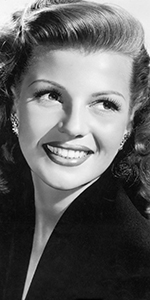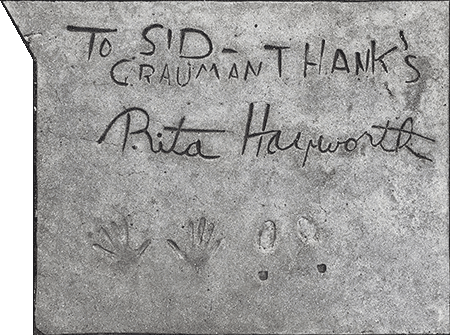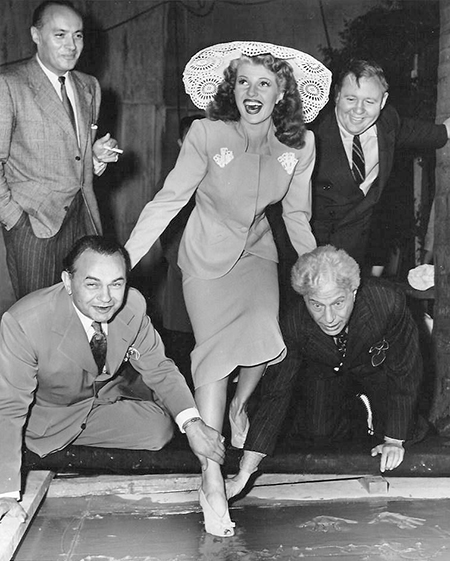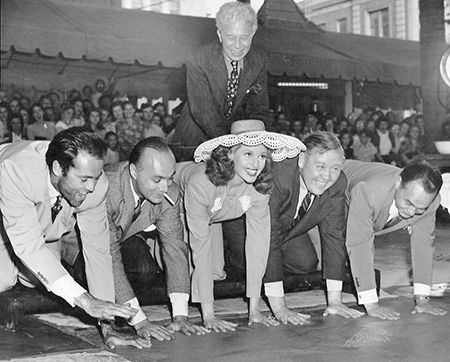 |
 |
 |
 |
 |
| Rita Hayworth; Unknown date. |
| |
|
 |
|
 |
| |
 |
| |
| |
|
|
| Rita Hayworth with Edward G. Robinson, Charles Laughton, Charles Boyer and Henry Fonda |
 |
| Forecourt Ceremony held on Friday, July 24, 1942 |
| |
Born: Margarita Carmen Cansino, October 17, 1918, in Brooklyn, New York
Age at the time of the ceremony: 23
Died: May 14, 1987, in New York City, New York, age 68 |
| |
Rita Hayworth was to become the most popular and glamorous film star / sex symbol of the World War II era. Beautiful and talented, Hayworth stared in many pictures during the 1940s; she had a colorful, if somewhat unhappy private life.
Margarita was born to a Spanish-born father, who was a dancer, and an Irish-English mother who had been a Ziegfeld Girl. From the age of three, Margarita was given dancing lessons from her father (and others), while her mother wanted the girl to become an actress. At the age of six, she was performing in public; with her father Eduardo, she appeared on Broadway in The Greenwich Village Follies during the 1923-1924 season, and took part in a short film called La Fiesta (released in 1926) for Warner Bros.
In 1927, father Eduardo moved the family to Hollywood, where he opened a dance studio, teaching the likes of James Cagney and Jean Harlow. The Depression wiped out this family enterprise. In 1931, Eduardo took 12-year-old Margarita with him to perform as the Dancing Cansinos in Tijuana Mexico (to escape the US child labor laws), at both the Foreign and Caliente clubs. While there, she performed in the films Cruz Dioablo (released in April 1935), and In Caliente (released in May 1935) with Delores del Rio.
An executive for the Fox studio saw the young dancer, and signed her to a short-term contract, then changed her name to Rita Cansino.
She was given small "exotic" roles in films like Under the Pampas Moon (which played the Chinese in June 1935) with Warner Baxter, and Charlie Chan in Egypt (played the Chinese in June 1935), and Dante's Inferno (released in August 1935) with Spencer Tracy.
Fox wanted to star Rita in the lead role of their Technicolor film of Ramona, but when the 20th Century-Fox merger brought Darryl F. Zanuck to power, he put Loretta Young in the role instead; they let Cansino's contract lapse.
Teaming up with promoter Edward C. Judson (who would become her first husband), Rita got roles in enough pictures to stay afloat until she was signed to a seven-year contract at Columbia Pictures. Her first film for the studio
was Meet Nero Wolfe (released in July 1936).
Columbia head Harry Cohn wanted Rita to emphasize the Anglo side of her heritage, since as an "exotic" she would have fewer roles. Judson agreed, so Rita adopted her mother's maiden name as her own — Hayworth. A full makeover turned her into an Anglo glamourpuss.
Columbia had never promoted a contract player to star status like other studios, so the road was rocky for Hayworth — at first. Her breakout film was Only Angles Have Wings (released in May 1939), with Cary Grant, and after that, she was starred in a tidalwave of films: Music in My Heart (released in January 1940), The Lady in Question (released in August 1940), and Angels Over Broadway (released in October 1940); she was loaned out to M-G-M for Susan and God (which played the Chinese in June 1940), and loaned out to Warner Bros. to co-star in The Strawberry Blonde (released in February 1941) with James Cagney. Warner Bros. attempted to buy Hayworth's contract from Columbia, but the wily Cohn refused.
Loaned out to 20th Century-Fox for the Tyrone Power hit Blood and Sand (which played the Chinese in May 1941), Hayworth returned to co-star with Fred Astaire in the most expensive film Columbia had ever made: You'll Never Get Rich (released in September 1941). The film was such a success that she was paired with Astaire again in You Were Never Lovelier (released in November 1942). Astaire went on the record to state that Hayworth had become his favorite dancing partner — which is saying a lot!
Rita Hayworth posed for a Life magazine photo where she appeared in a negligee, kneeling on a bed. It became the most popular pin-up of World War II. In March 1942, she made a goodwill trip to Brazil on behalf of the US Government.
Hayworth was one of the five actors from the film Tales of Manhattan to be imprinted on the same day at Grauman's Chinese Theatre. Tales would have its World Premiere at the Chinese two weeks later, in August 1942.
Hayworth married wunderkind actor/director Orson Welles in 1943, and together, they had a daughter, Rebecca in 1944. Back to the cameras, she filmed the musicals
Cover Girl (released in April 1944) with Gene Kelly, Tonight and Every Night (released in January 1945), Down to Earth (released in August 1947) with Larry Parks, and also most famously, in the noir drama Gilda (released in March 1946) with Glenn Ford, and which remains her signature role.
Husband Welles, struggling in his career, put wife Hayworth in his film The Lady from Shanghai (released in April 1948) sporting a shortened, bleach blonde haircut. Fans spurned the look, and the picture bombed, straining the already fragile marriage.
Wooed away from both Welles and Hollywood by war hero and Muslim religious leader, Prince Ali Kahn, Hayworth married the notorious playboy / horsebreeder in 1949 and produced a daughter, Yasmin. Away from her film career, Hayworth met with much interest from the press, but also anger from her fans, who were shocked at her antics. The couple split in 1951, and divorced in 1953.
Amazingly, Hayworth still owed movies to Columbia on her contract. Affair in Trinidad (released in July 1952) with Glenn Ford was a hit, and so, was followed by: Salome (released in March 1953) with fellow Tales of Manhattan co-star Charles Laughton, and Miss Sadie Thompson (released in December 1953) with José Ferrer. That year, she married singer / actor Dick Haymes, a marriage which was quite rocky, generating much negative publicity. The couple divorced in 1955.
Hayworth was still a big star for Columbia though: Fire Down Below (released in June 1957) with Robert Mitchum, was a hit, then, she was put in Pal Joey (released in October 1957) paired with the "new girl" at Columbia — Kim Novak. After this, she left Columbia for good.
She married her Separate Tables (released in December 1958) producer James Hill in 1952, but their marriage was stormy. They divorced in 1961. She continued to make films like:
The Story on Page One (released in December 1959), directed by Clifford Odets (!), The Money Trap (released in February 1966) with Glenn Ford, and her last film, The Wrath of God (released in July 1972) with Robert Mitchum.
An alcohol problem masked Hayworth's true condition: Alzheimer's disease. In financial straights, she was looked after by her daughter, Princess Yasmin. In February 1987, she lapsed into a coma, and died three months later at home in Manhattan. She was 68. |
|
|
|
|
| |
 |
 |
| Grauman's Chinese Theatre, Hollywood, California. Rita Hayworth Forecourt block. Executed by Jean Klossner, Friday, July 24, 1942. 51 x 39 inches overall. |
 |
 |
 |
|
 |
 |
 |
| Grauman's Chinese Theatre, Hollywood, California. Rita Hayworth Forecourt ceremony, Friday, July 24, 1942. Sid Grauman presides over the co-stars of the film Tales of Manhattan: Henry Fonda, Charles Boyer, Rita Hayworth, Charles Laughton, and Edward G. Robinson. |
|